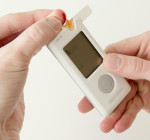A lot of T2 diabetics are focused on their blood glucose levels. They monitor it and they want medication that will make it go down. But that’s the wrong thing to focus on. Kinda.
Blood glucose is a side effect of what the problem really is. High blood glucose, i.e. diabetes, it generated by two causes:
1) High glucid intake.
2) Insulin resistance.
1) High glucid intake is purely a result of diet: if you eat too much carbs and sugar, you’ll have a very high glucid intake. This is a recent development in diets. Until the 19th century, access to carbohydrates wasn’t easy. Apart from bread, most food was low carb. So even high bread diets were offset by low carb everything else. In the 20th century, carbohydrates availability has increased greatly, leading to an epidemic of T2 diabetes (which used to be called adult onset diabetes).
The human body is designed to store carbs during good times, in order to handle lean times. So when you have access to carbs, you eat them, your body makes you, then during periods when you don’t have access to them, you use your reserves. If you have outdoors cats you’ll have seen it: your cat will put on weight during the summer, becoming fat, then losing that weight during the winter.
These cycles of fat and lean times balance over time, so that you don’t end up with long term storage of energy in your body. Unfortunately, now that we live in cities or villages, with easy access to any kind of food we want, our cravings for carbs during fat periods never stop, and we never go through lean times. So our reserves are ever increasing.
The body has only one thing it can do with excessive carbs: it stores carbs, converted into glucose, as fat. There is no other thing it can do. So as these periods of fat times are never-ending, your body constantly stores fat. Unfortunately, the body has a limited amount of safe storage space for that fat. Once that threshold is crossed, bad things happen.
2) The history of T2 diabetes usually starts with insulin resistance. Sometimes 10 years before any signs of diabetes. That resistance impairs the ability of muscles to take glucose from the blood. At that point, there are usually no outward signs of this happening, and until insulin testing is generalised, it will continue to be missed.
As insulin resistance develops, the pancreas secretes more and more of it into the blood to compensate. Unlike T1 diabetics, T2 diabetics aren’t short of insulin. They usually have insane amounts in their body because that’s the only way to force cells to take glucose out of the bloodstream.
One consequence of that increase in insulin, is to force the liver to store some of the glucose it finds in the blood as fat instead of glycogen. Glycogen can be released into the bloodstream to send energy to the muscles when they need it. Not fat. The fat stored in the liver gets stuck there and leads to triglycerides to be released into the blood and reaching the pancreas. And that fat impairs the normal functioning of the liver which becomes “fatty” and ineffective.
Another side effect of increasing insulin levels in the blood is to increase insulin resistance because cells just can’t take more glucose in and therefore start ignoring insulin signals. So the body, trying to compensate for insulin resistance, in facts exacerbates that resistance. It creates a vicious circle until the pancreas can’t produce more and the Beta cells dedifferentiate and become ineffective.
That is why, taking insulin to treat T2 diabetes is just a stop-gap and it will transform the condition into a progressive disease: you inject insulin because your body can’t produce more, but in doing so you train your body to ignore the additional insulin you inject. At some point you’ll reach the limit of what you can take.
For these two reasons, focusing on blood glucose and taking medication that lowers it isn’t treating the root cause of diabetes. You can lower blood glucose, which will avoid side effects (neuropathy, infections, and various conditions associated with diabetes), but it will never treat the cause of diabetes, and therefore will never correct it. You’ll live your life with it.
This is why I mentioned before that T2 diabetics should aim for no medication: medication will not lead out of the diabetes vicious cycles. It will only perpetuate them. It can be of help when attacking the root causes of diabetes, but it can’t be a end in itself. And it’s certainly not a excuse to allow diabetics to continue their bad eating.
The only effective course of action to treat diabetes is weight loss. As we know that it’s excessive fat storage that triggers the vicious circles that lead to diabetes, removing that excessive fat via weight loss is the solution. Unfortunately, there is no clear target for that weight loss. Each body has a “personal fat threshold” above which additional fat storage is not safe. And it’s not just obese people that cross that threshold. In fact 72% of people with a BMI above 40kg/m2 are not T2 diabetics, and thin people can be T2 diabetics. When you’re diabetic, all you know is that you’re above that threshold and you need to get below it. Some studies place the weight loss at 15kg (DiRECT), others at 10% of body weight (Counterpoint), with the benefit tapering off at about 20% of body weight loss.
That weight loss needs to be achieved as fast as possible. Studies have placed a time limit after onset of diabetes after which it becomes impossible to reverse diabetes completely: 8 years according to DiRECT, 10 years according to Counterpoint. What the limit is exactly isn’t important. The message is that it needs to be done fast.
This is why focusing on glucose levels is looking at the condition the wrong way. What we should focus on is getting rid of fat. Therefore weight should be the focus, not glycaemia.



